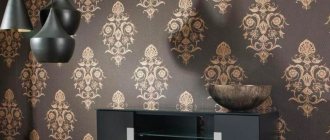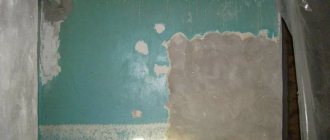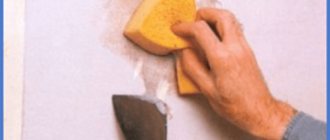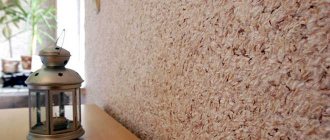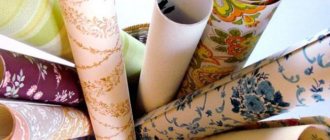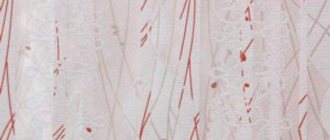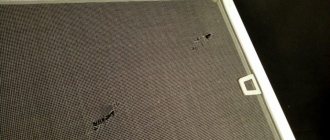/Repair/Walls/
Removing the remains of old wallpaper before gluing new ones or before priming the walls is a necessary procedure, because even very small pieces create unevenness and can cause peeling of the coating in the future. So we arm ourselves with a spatula and our article.
- Let's move from simple to complex: different types of wallpaper capitulate in different ways, some only surrender with a fight. As a rule, it is easy to remove paper wallpaper, but multilayer wallpaper (vinyl and non-woven) requires dissolving the glue.
Before removing the wallpaper using special compounds, pry the edge of the corner with a knife or spatula and pull: the wallpaper can come off easily and immediately in a large strip. Usually such joy awaits the owners of old apartments with paper wallpaper, where the canvases have been hanging for ten years, and voids have formed between the wall and the paper. If this is not your case, read on.
How to remove paper wallpaper using water
High-quality wallpaper has one drawback - it is not so easy to remove it, because it comes off the wall in small pieces.
- Important: do not try to use the spatula intensively and deeply. It can leave grooves on the wall that will require additional putty to cover.
If paper wallpaper doesn't come off well, the first thing you should try is to wet it with water.
Our work plan:
- All furniture is moved to the middle of the room and covered with protective film. If your plans do not include repairing the floor, cover it too. Otherwise, wet pieces of wallpaper with liquefied glue, falling to the floor, will stick to it, leaving an unpleasant “mosaic” that will then need to be torn off with force. It is also very important to turn off the electricity.
- Wet the wallpaper thoroughly with water. It is best to free a small area from the wallpaper at the top and move away from it, wetting the surface with a sponge and water or from a spray bottle (a more convenient option). If the wallpaper is difficult to yield, be patient and diligent: you need to moisten the canvas more and wait a little longer.
- We wait a few minutes and remove the wallpaper. After a few minutes, you will feel that the glue is dissolving and the wallpaper is “floating” on it, gently separating from the wall. There is no need to waste time either: wallpaper that gets too wet will crumble into small pieces, like pellets on clothes.
- Let the wall dry before applying new wallpaper. When the wallpaper is removed, the wall should dry thoroughly, so don’t rush to hang new wallpaper.
How to prevent stains?
To avoid having to deal with the problem of stains on wallpaper in the future, you need to follow simple recommendations:
Don't skimp on buying brushes. To apply the glue evenly and accurately, you need to choose a tool with natural bristles.- If excess glue appears, it must be removed immediately with a clean, damp cloth.
- You should not apply too much glue to the wallpaper strip so that it does not protrude beyond its borders.
- For a better fit of the material to the wall, you need to go over it with a roller. For this purpose, use only clean tools.
How to remove vinyl and non-woven wallpaper using home methods (without special compounds)
Vinyl and non-woven wallpaper have relatively greater moisture resistance, and the glue will not come off easily, so we will study separately how to remove these types of wallpaper. In cases where a spatula and a sponge with ordinary water are powerless, you need to fight not with the wallpaper itself, but with the durability of the glue that holds it in place. Depending on the type of glue, you can choose one or another composition that is applied in liquid form and reaches the adhesive bond. And we have good news: sometimes you can use homemade cleaners instead of special products. For example, it could be: soap, dishwashing gel, fabric softener or washing powder.
- They are based on surfactants (surfactants) that dissolve fat. Usually it helps to remove canvases glued in one layer. For paper wallpaper, a small amount will be enough; for vinyl and non-woven wallpaper, we make a greater concentration.
The cheapest fabric softener will help dissolve glue and remove wallpaper
The disadvantage of using such products, which are found in every home, is lower efficiency compared to special products from hardware stores, as well as abundant foam. The fact is that defoamers are added to wallpaper removal compositions so that your renovation does not turn into a foam party. However, if you don't mind a small party, you can test home remedies on a small area of wallpaper, or even remove the wallpaper from the walls completely.
Here are a few recipes on how to quickly remove wallpaper using a homemade solution from home remedies:
- In order not to wash the sponge with laundry soap, it is more convenient to grate the piece, add water to cover the shavings by 2-3 fingers, and leave overnight. The shavings will dissolve and the solution is ready!
- You can buy the most budget-friendly washing powder: we only need solvents from it. Pour the powder into hot water in a ratio of 1:10, mix gently without creating excess foam. It forms one way or another, so we wait for the foam to settle and apply the solution to the wallpaper.
- The same scheme applies to dishwashing detergent, but you need to remember that gel detergents are more concentrated, and a ratio of 1:50 will do, but liquid dishwashing detergents (usually they have a lower price) require less water for the concentration to be viable for fighting wallpaper with glue.
Having prepared the solution, go over the walls with a needle roller or a regular/painting knife, then spray the product onto the canvases from a spray bottle (you can use a roller or brush), wait 5 minutes and wet the wallpaper again. Next, wait another 5 minutes and try to remove the panels by prying them off with a spatula.
How to choose a special composition for removing wallpaper
There are several types of special wallpaper removers:
- Products containing acids and solvents
Suitable for dissolving superglue and bustylate. Be careful: they evaporate quickly before the wallpaper has time to soak, so you need quite a lot of product, which has the pungent smell of acetone. In a small, unventilated room, this can lead to poor health and even poisoning, so watch your work.
- Alkaline compounds
The alkali effectively penetrates the wallpaper, so it can handle both vinyl and multi-layer wallpaper. Important: protect exposed areas of the body from alkaline agents and wear special gloves.
- Products with surfactants and defoamers
This is the easiest and most non-toxic type of wallpaper remover. Keep in mind: surfactants work quickly with paper wallpaper, but vinyl and non-woven fabric require a stronger concentration of this composition.
Popular types of wallpaper removers
When going to the store to buy wallpaper remover, you need to know what kind of glue and what kind of wallpaper was used in the repair. In this case, the choice will be the most appropriate. Almost always on the shelves there is:
Metylan - removes both paper and vinyl wallpaper, has no odor, does not leak, and is used quite economically if prepared according to the instructions.
Dissoucol is a non-toxic and biodegradable product that will help remove thin and vinyl wallpaper, and even whitewash.
Anti-wallpaper Kleo is an alkaline preparation with great “endurance”: it will dissolve even several layers of wallpaper. Be careful: alkaline concentrate is dangerous when working without gloves and face protection!
How to remove old heavy and multi-layer wallpaper (vinyl, non-woven, washable)
Multi-layer wallpaper is usually called heavy panels. To glue them, stronger glue is used, and the high strength does not allow the coating to be easily soaked with water. In this case, how to remove vinyl or non-woven wallpaper without suffering for half a day?
- Vinyl wallpaper is a “sandwich” made of PVC and non-woven fabric or paper. Non-woven wallpaper is a durable material made from compressed and glued fibers.
Here are instructions on how to quickly remove these types of wallpaper:
- We move the furniture to the middle of the room, cover everything that can get dirty, and turn off the electricity.
- According to the instructions, we prepare a solution for removing wallpaper purchased at a hardware store.
- First, we make notches on the wallpaper so that the composition penetrates deeper and does not flow down the water-repellent layer. This is easy to do with a needle roller (it’s faster and easier), but a regular knife will do.
Tip: A needle roller is exactly the secret weapon that allows you to remove any wallpaper quickly and easily. If it is not there, then you can ensure access of water/solution to the adhesive layer by making notches using a regular/painting knife. The third alternative is to remove the top layer of the canvas using a spatula. Simply scrape it along the walls to expose the underlying layers for later soaking.
- Apply wallpaper remover using a sponge, roller or spray bottle. Quite generously, but without unnecessary splashes.
- After some time, the wallpaper will become wet and will come off easily. We first pry them off from the edge, trying to immediately release a large piece of the cloth.
- After the main work, we go through small pieces, carefully cleaning them with a spatula or knife.
- Before the next stage of repair, you need to wipe the wall and wait for it to dry. Great job!
Features of removing paper wallpaper from the wall
When the preparatory work is completed, you can begin to remove the old coating:
- pour the prepared solution into the container;
- Apply the liquid onto the paper coating with a roller;
- use a brush to treat hard-to-reach areas and corners;
- wait a while to cover everything well;
- using a sharp tool, pry up the wallpaper and pull it down with your hands;
- if a piece of coating is difficult to tear off, you must use a spatula;
- collect old wallpaper and remove it from the room;
- remove all trash.
How to remove liquid wallpaper
Another challenge lies ahead for those who need to remove liquid wallpaper. After all, this is not wallpaper in the usual sense of the word, but a finish similar to plaster, tightly fixed to the wall. However, there is no difficulty in this: we protect the floors, door, baseboards, sockets and furniture remaining in the room, and get started.
Work options:
- Removing liquid wallpaper with water and a spatula. If no varnish is applied over the coating, then we can also soak the glue with water:
- Wet the surface of the walls well with a roller or clean brush;
- We wait about 10 minutes;
- We check “readiness” with a spatula: the wallpaper should come off easily;
- Remove the wet layer.
Tip: You can add some detergent or fabric softener to the water.
- Removing liquid wallpaper using construction tools. Removing liquid wallpaper using this method is fraught with a lot of dust, so protect the room and face, wear glasses and a respirator. In this case, a grinder or grinder is used for removal. You need to work very carefully.
- A hair dryer can also handle liquid wallpaper. Hot air peels off the coating, which then simply lags behind the wall. In this case, the wallpaper can be pre-wetted.
- Lightening a layer or priming liquid wallpaper without removing it. The methods given above are quite labor-intensive. Therefore, if you are satisfied with the texture of the surface and want to change only its color, then you can go the simple route: apply a layer of light water-based paint to the old liquid wallpaper. After drying, it forms a layer that will not show through when applying new liquid wallpaper.
How to remove yellow stains on the ceiling?
In the most difficult cases, you will need to treat with ordinary soda ash. A 5% solution will help to clean the canvas, which should be applied to the painted area, wait until it dries, and then rinse with warm water. This procedure can be repeated several times until the stain completely disappears.
Interesting materials:
How to select all folders on the desktop? How to travel to Ukraine from Russia? How to iron a jacket? What is the best way to close a mortgage early? How to pay off your mortgage profitably? How to upload a 1c database to XML? How to win a green card to America? How to win a green card? How to exit offline mode? How to exit safe mode in Lenovo?
How to remove wallpaper from a plasterboard wall
Problems with removing wallpaper in this case are often associated with the fact that previous masters glued it directly onto drywall without a layer of putty. A double blow - if it is also paper wallpaper, which is firmly glued and not separated into layers, like non-woven fabric.
- In order not to injure the plasterboard wall and not soak it with large amounts of water, many use the properties of steam. Construction stores have a special steamer for wallpaper with a large coverage area. If, alas, you don’t have one, then you can use the experience of people who have calmly used a household steamer or even an ordinary iron with steam.
This method has one disadvantage - if there are a lot of walls, then the work will be quite troublesome. If you don’t have the strength or desire to fool around with steam, head to a hardware store for a special wallpaper remover. This method is good because the special composition will only act on the adhesive layer, and the plasterboard wall itself will simply dry and remain as if untouched.
Support the project - share the material with your friends on social networks:
